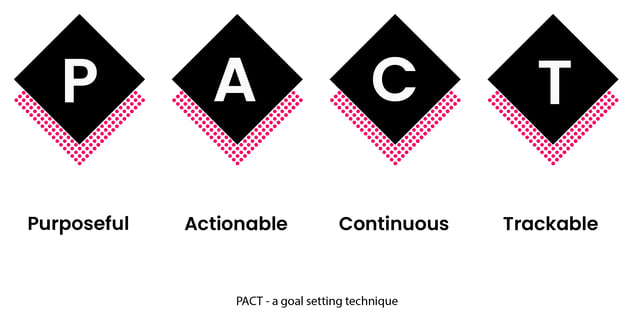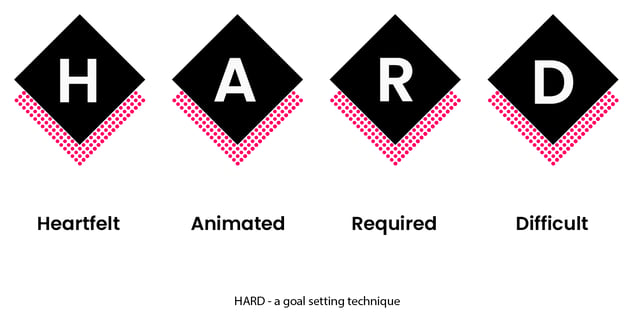Growing your business is a long journey, and it requires aligning everyone behind a set of shared goals that everyone is working toward achieving. Shared business goals based on high values and ethics help to inspire and create a shared sense of accountability and transparency across your teams.
Taking the first step to a successful business journey requires setting goals, which psychologists associate with higher predictability of success. Setting business goals is creating a roadmap for the long run and giving meaning to the actions of everyone involved.
Three Main Goals That Every Organization Needs:
- Outcome goals - It's about choosing your destination. What do you plan to achieve?
- Process goals - What's the execution plan to get to your desired destination?
- Performance goals - What's your measurement plan to analyze your progress?
The Importance of Goal Setting for Your Business:
- Provides a clear direction and focus for your business
- Maximizes the success of your business
- Minimizes the failures and disappointments
- Optimizes your employees' abilities
- Motivates your employees
The best way to establish realistic goals is to be aware of your weaknesses and strengths and then decide on taking actions that align with your potential.
Five Dimensions to Categorize Your Business Goals:
To increase awareness of how goal formulations can be analyzed and improved, you can use the following dimensions to separate your goals:
- Proximity: long-term or short-term goal
- Specificity: clear or vague
- Action-orientation: approach or avoidance
- Purpose: learning or performance
- Duration of involvement: process or end-state.
Setting business goals can be complicated, but having an organized view of your big picture can simplify it. That's why you need a goal-setting technique.
3 Effective Goal-Setting Techniques
Goal-setting techniques impact both intrinsic and extrinsic motivation and represent the framework to set the direction and focus on achieving your business goals. You can use different methods to prepare your plan of action and give your mind the power to envision your business's ideal future.
Here we will cover the following practical strategies for setting goals to drive a more significant impact:
-
SMART goals
-
PACT goals
-
HARD goals
1. SMART Goals
The Smart goals (S-M-A-R-T) framework enables you to define and write specific, measurable, achievable, realistic, and time-bound goals. Here you can find a goal-setting template with the SMART approach. When you write goals with each of these aspects in mind, you'll be able to quantify how far you've progressed.
- Specific goals are well-defined and significant goals that target a particular area of your business for improvement.
- Measurable goals are progress indicators with specific criteria to quantify your advancement toward the accomplishment.
- Achievable goals are goals you don't link to fate or outside influences; instead, you determine them with your resources in mind, and there are real chances to attain them.
- Relevant goals are realistic, relevant, and coordinated with your business' purpose.
- Time-bound goals are limited in time and create urgency. A clearly defined timeline includes a starting date and an end date

2. PACT Goals
The PACT technique focuses on continuous growth, and businesses commonly use it for setting long-term and ambitious goals.
-
Purposeful goals are meaningful goals aligned with the long-term purpose of your business.
-
Actionable goals focus on outputs and actions you can take and control to achieve them. They inspire action so the team knows where to focus and what to do to achieve the desired outcomes.
-
Continuous goals refer to the constant actions that help you achieve your goal. It encourages continuous improvement rather than reaching a supposed end goal.
-
Trackable goals are smaller goals that allow you to track the progress of your activities towards the larger goal.

3. HARD Goals

In his book, "Hard Goals - The secret to getting from where you are to where you want to be," Mark Murphy explains that, unlike achievable and realistic goals that leave you stuck in the status quo, HARD goals light up the brain and encourage excellent performance.
He says, "People spend too much time figuring out how to trick themselves into implementing mediocre goals. Instead, we need unique goals—HARD Goals."
HARD is an acronym for setting Heartfelt, Animated, Required, and Difficult goals.
- Heartfelt: Choose a goal that makes everyone in your team emotionally attached to it and motivates you to move forward to achieve it.
- Animated: Envision what achieving your business goal would look like to connect with it on a deeper level.
- Required: Connect your goal to something essential for your company's success.
- Difficult: Set a goal that challenges you to move from your comfort zone and engage your brain to become high achievers.
Conclusion
The most important thing for every organization is to have a clear purpose and define goals aligned with it. It helps to see the big picture for your business, align all the efforts in the right direction, and ultimately achieve the desired business goals.
The purpose also influences the mind to change for the better and contributes to making more intelligent decisions.
"Begin with the end in mind" and build an effective plan for your business.
Want to learn more about inbound marketing? Go to our blog and find some insightful tips to help your business grow!
.png)


